gas type TOYOTA LAND CRUISER 2011 J200 Owners Manual
[x] Cancel search | Manufacturer: TOYOTA, Model Year: 2011, Model line: LAND CRUISER, Model: TOYOTA LAND CRUISER 2011 J200Pages: 608, PDF Size: 8.29 MB
Page 94 of 608
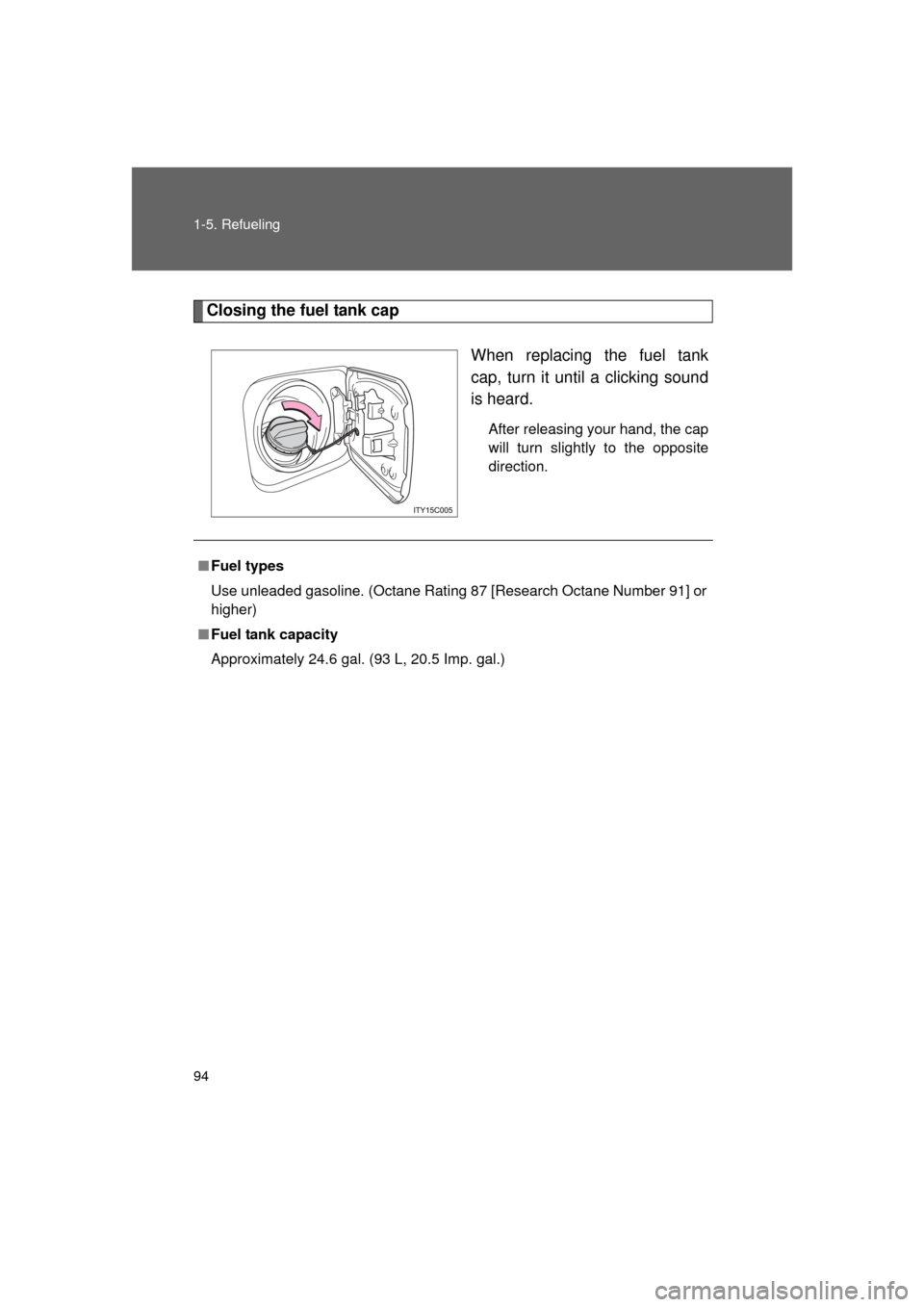
94 1-5. Refueling
L/C200_U (OM60F74U)
Closing the fuel tank capWhen replacing the fuel tank
cap, turn it until a clicking sound
is heard.
After releasing your hand, the cap
will turn slightly to the opposite
direction.
■Fuel types
Use unleaded gasoline. (Octane Rating 87 [Research Octane Number 91] or
higher)
■ Fuel tank capacity
Approximately 24.6 gal. (93 L, 20.5 Imp. gal.)
Page 108 of 608
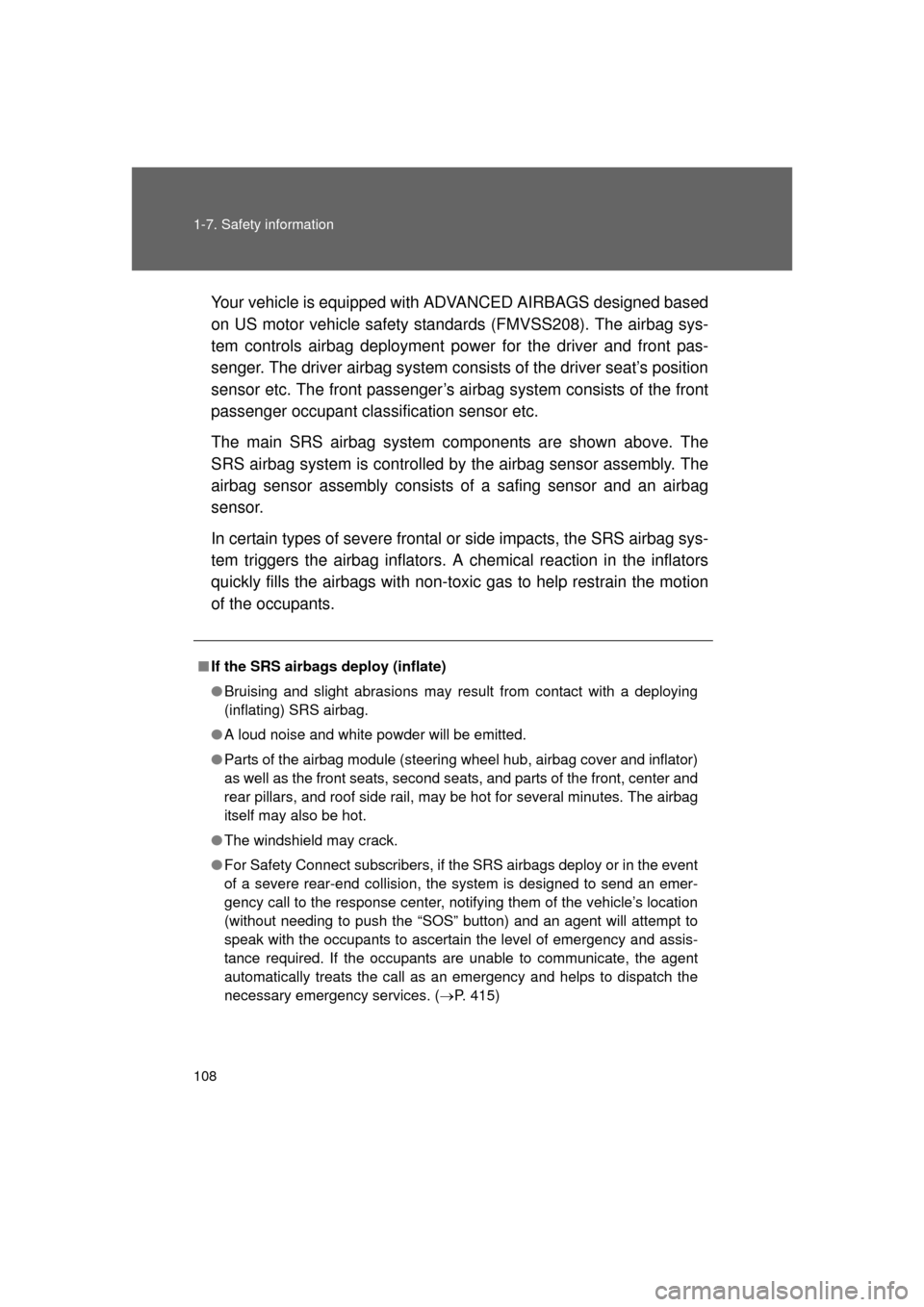
108 1-7. Safety information
L/C200_U (OM60F74U)Your vehicle is equipped with
ADVANCED AIRBAGS designed based
on US motor vehicle safety standards (FMVSS208). The airbag sys-
tem controls airbag deployment po wer for the driver and front pas-
senger. The driver airbag system consists of the driver seat’s position
sensor etc. The front passenger’s airbag system consists of the front
passenger occupant classification sensor etc.
The main SRS airbag system components are shown above. The
SRS airbag system is controlled by the airbag sensor assembly. The
airbag sensor assembly consists of a safing sensor and an airbag
sensor.
In certain types of severe frontal or side impacts, the SRS airbag sys-
tem triggers the airbag inflators. A chemical reaction in the inflators
quickly fills the airbags with non-toxic gas to help restrain the motion
of the occupants.
■ If the SRS airbags deploy (inflate)
● Bruising and slight abrasions may result from contact with a deploying
(inflating) SRS airbag.
● A loud noise and white powder will be emitted.
● Parts of the airbag module (steering wheel hub, airbag cover and inflator)
as well as the front seats, second seats, and parts of the front, center and
rear pillars, and roof side rail, may be hot for several minutes. The airbag
itself may also be hot.
● The windshield may crack.
● For Safety Connect subscribers, if the SRS airbags deploy or in the event
of a severe rear-end collision, the system is designed to send an emer-
gency call to the response center, notifying them of the vehicle’s location
(without needing to push the “SOS” button) and an agent will attempt to
speak with the occupants to ascertain the level of emergency and assis-
tance required. If the occupants are unable to communicate, the agent
automatically treats the call as an emergency and helps to dispatch the
necessary emergency services. ( P. 415)
Page 429 of 608
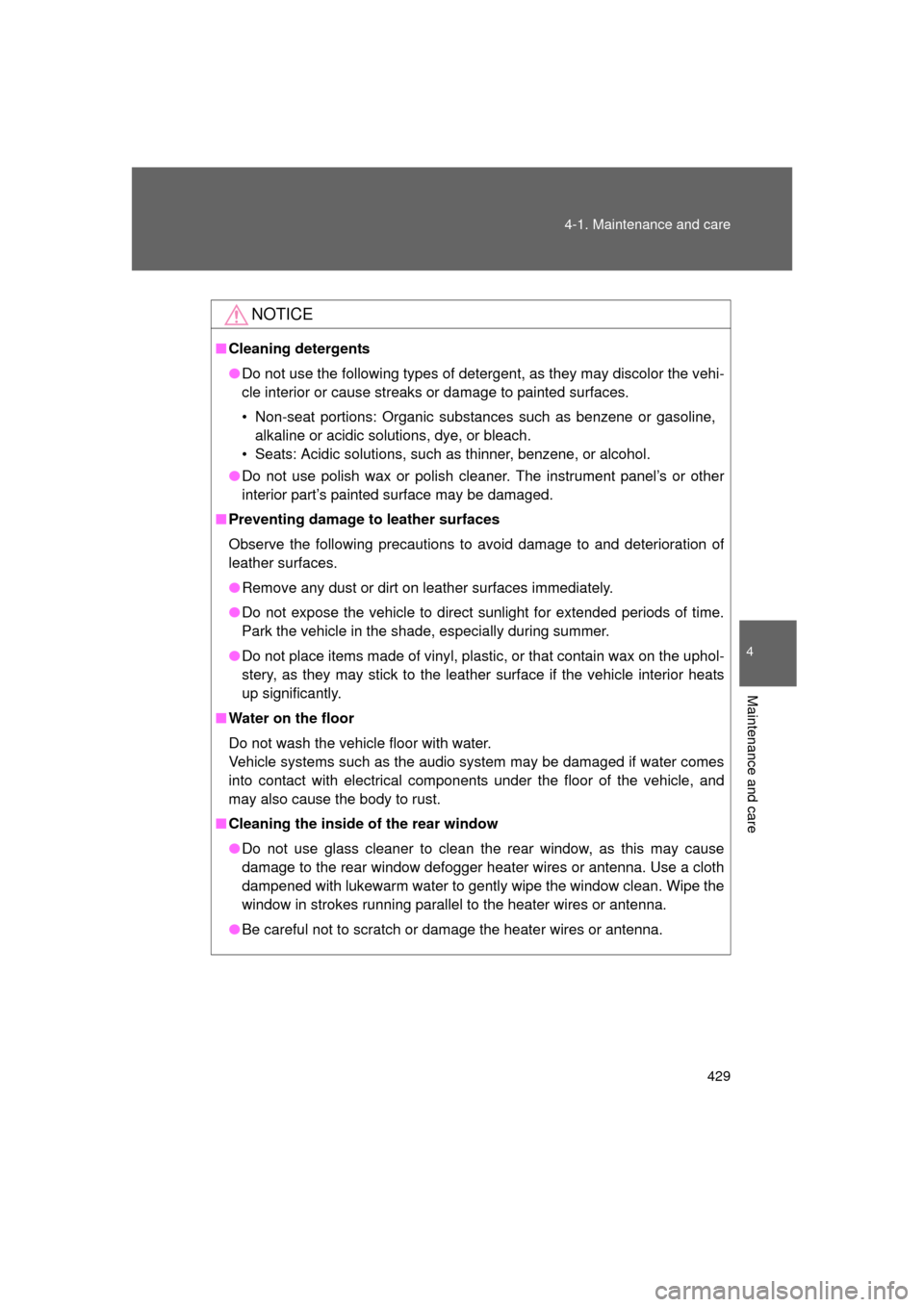
429
4-1. Maintenance and care
4
Maintenance and care
L/C200_U (OM60F74U)
NOTICE
■
Cleaning detergents
● Do not use the following types of detergent, as they may discolor the vehi-
cle interior or cause streaks or damage to painted surfaces.
• Non-seat portions: Organic substances such as benzene or gasoline,
alkaline or acidic solutions, dye, or bleach.
• Seats: Acidic solutions, such as thinner, benzene, or alcohol.
● Do not use polish wax or polish cleaner. The instrument panel’s or other
interior part’s painted surface may be damaged.
■ Preventing damage to leather surfaces
Observe the following precautions to avoid damage to and deterioration o\
f
leather surfaces.
● Remove any dust or dirt on leather surfaces immediately.
● Do not expose the vehicle to direct sunlight for extended periods of time.
Park the vehicle in the shade, especially during summer.
● Do not place items made of vinyl, plastic, or that contain wax on the uphol-
stery, as they may stick to the leather surface if the vehicle interior heats
up significantly.
■ Water on the floor
Do not wash the vehicle floor with water.
Vehicle systems such as the audio system may be damaged if water comes
into contact with electrical components under the floor of the vehicle, and
may also cause the body to rust.
■ Cleaning the inside of the rear window
● Do not use glass cleaner to clean the rear window, as this may cause
damage to the rear window defogger heater wires or antenna. Use a cloth
dampened with lukewarm water to gently wipe the window clean. Wipe the
window in strokes running parallel to the heater wires or antenna.
● Be careful not to scratch or damage the heater wires or antenna.
Page 452 of 608
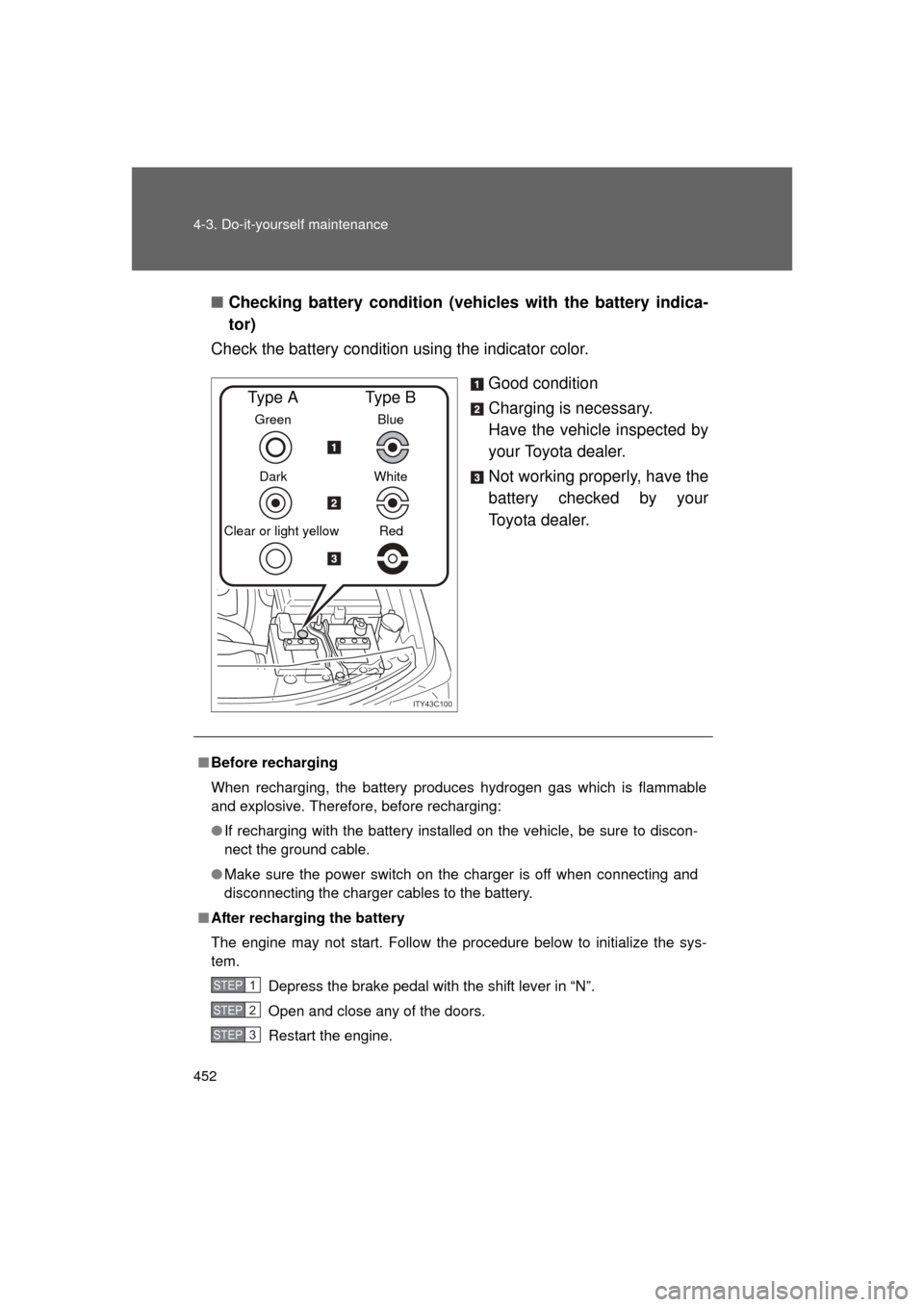
452 4-3. Do-it-yourself maintenance
L/C200_U (OM60F74U)■
Checking battery condition (veh icles with the battery indica-
tor)
Check the battery condition using the indicator color.
Good condition
Charging is necessary.
Have the vehicle inspected by
your Toyota dealer.
Not working properly, have the
battery checked by your
Toyota dealer.
ITY43C100
Green
Dark
Clear or light yellow
Type A
Blue
White Red
Type B
■ Before recharging
When recharging, the battery produces hydrogen gas which is flammable
and explosive. Therefore, before recharging:
● If recharging with the battery installed on the vehicle, be sure to discon-
nect the ground cable.
● Make sure the power switch on the charger is off when connecting and
disconnecting the charger cables to the battery.
■ After recharging the battery
The engine may not start. Follow the procedure below to initialize the sys-
tem.
Depress the brake pedal with the shift lever in “N”.
Open and close any of the doors.
Restart the engine.
STEP1
STEP2
STEP3
Page 560 of 608
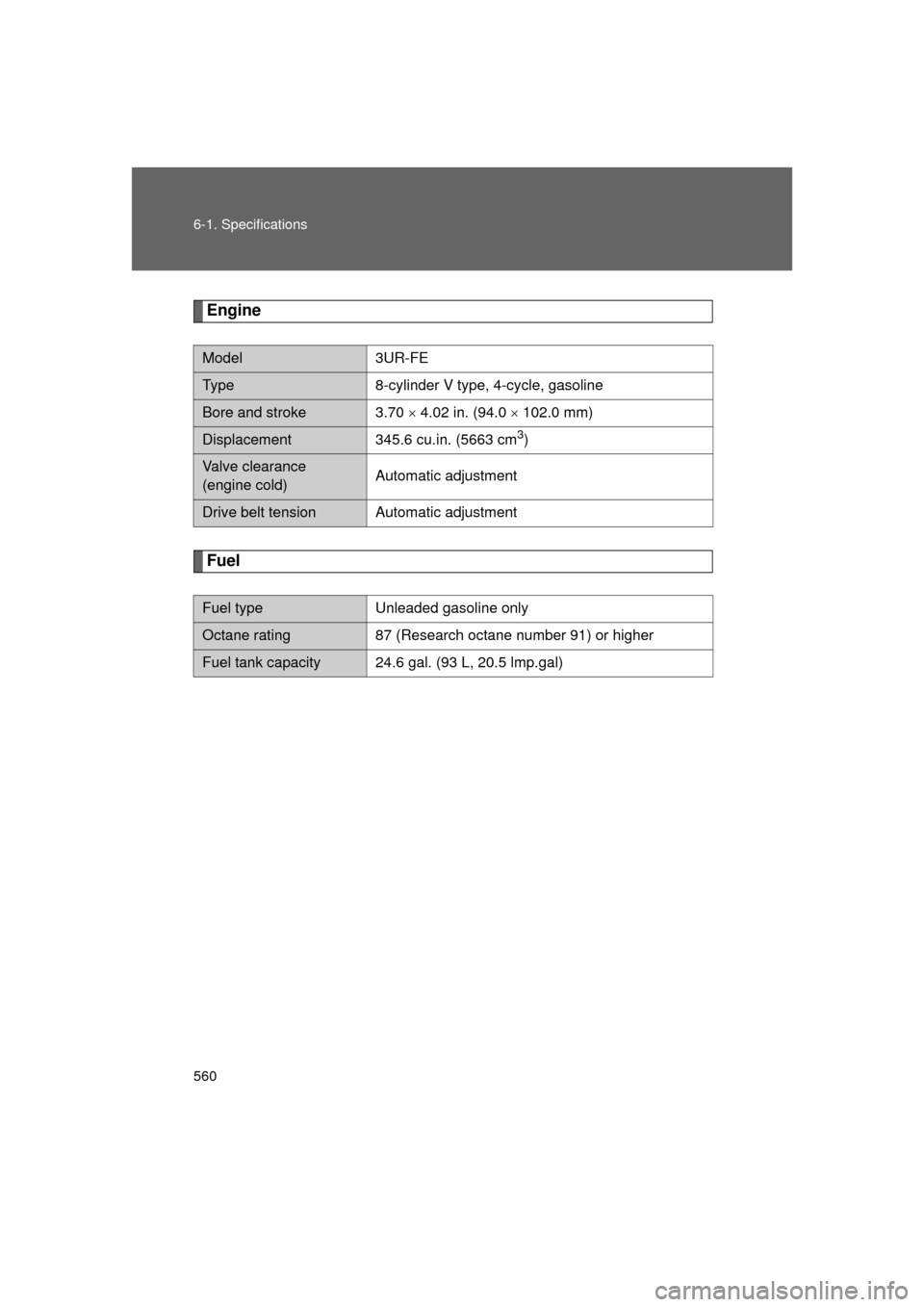
560 6-1. Specifications
L/C200_U (OM60F74U)
Engine
Fuel
Model3UR-FE
Ty p e8-cylinder V type, 4-cycle, gasoline
Bore and stroke3.70 4.02 in. (94.0 102.0 mm)
Displacement345.6 cu.in. (5663 cm3)
Valve clearance
(engine cold)Automatic adjustment
Drive belt tensionAutomatic adjustment
Fuel typeUnleaded gasoline only
Octane rating87 (Research octane number 91) or higher
Fuel tank capacity24.6 gal. (93 L, 20.5 lmp.gal)
Page 569 of 608
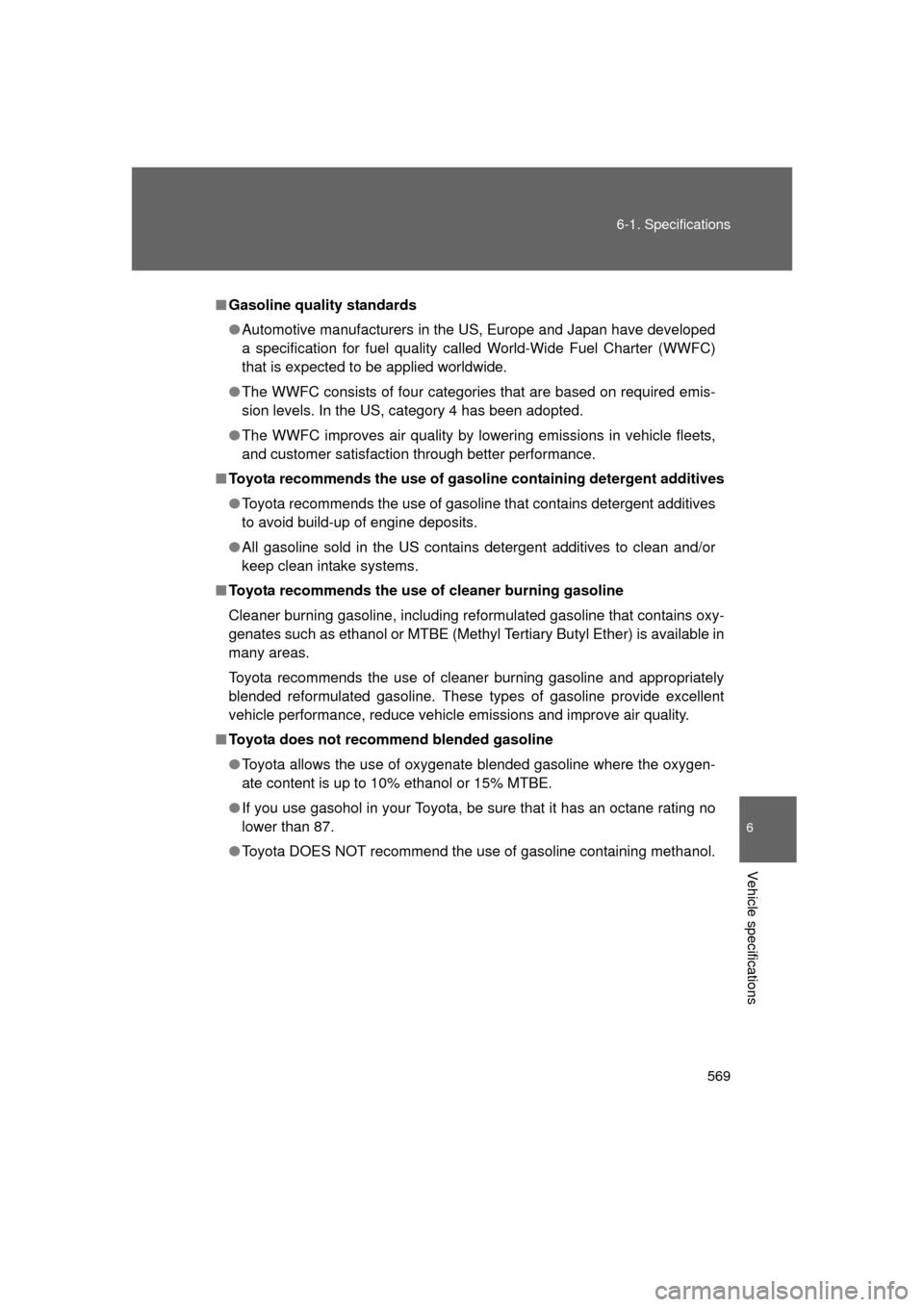
569
6-1. Specifications
6
Vehicle specifications
L/C200_U (OM60F74U)
■
Gasoline quality standards
● Automotive manufacturers in the US, Europe and Japan have developed
a specification for fuel quality called World-Wide Fuel Charter (WWFC)
that is expected to be applied worldwide.
● The WWFC consists of four categories that are based on required emis-
sion levels. In the US, category 4 has been adopted.
● The WWFC improves air quality by lowering emissions in vehicle fleets,
and customer satisfaction through better performance.
■ Toyota recommends the use of gaso line containing detergent additives
● Toyota recommends the use of gasoline that contains detergent additives
to avoid build-up of engine deposits.
● All gasoline sold in the US contains detergent additives to clean and/or
keep clean intake systems.
■ Toyota recommends the use of cleaner burning gasoline
Cleaner burning gasoline, including reformulated gasoline that contains oxy-
genates such as ethanol or MTBE (Methyl Tertiary Butyl Ether) is available in
many areas.
Toyota recommends the use of cleaner burning gasoline and appropriately
blended reformulated gasoline. These types of gasoline provide excellent
vehicle performance, reduce vehicle emissions and improve air quality.
■ Toyota does not recommend blended gasoline
● Toyota allows the use of oxygenate blended gasoline where the oxygen-
ate content is up to 10% ethanol or 15% MTBE.
● If you use gasohol in your Toyota, be sure that it has an octane rating no
lower than 87.
● Toyota DOES NOT recommend the use of gasoline containing methanol.
Page 570 of 608
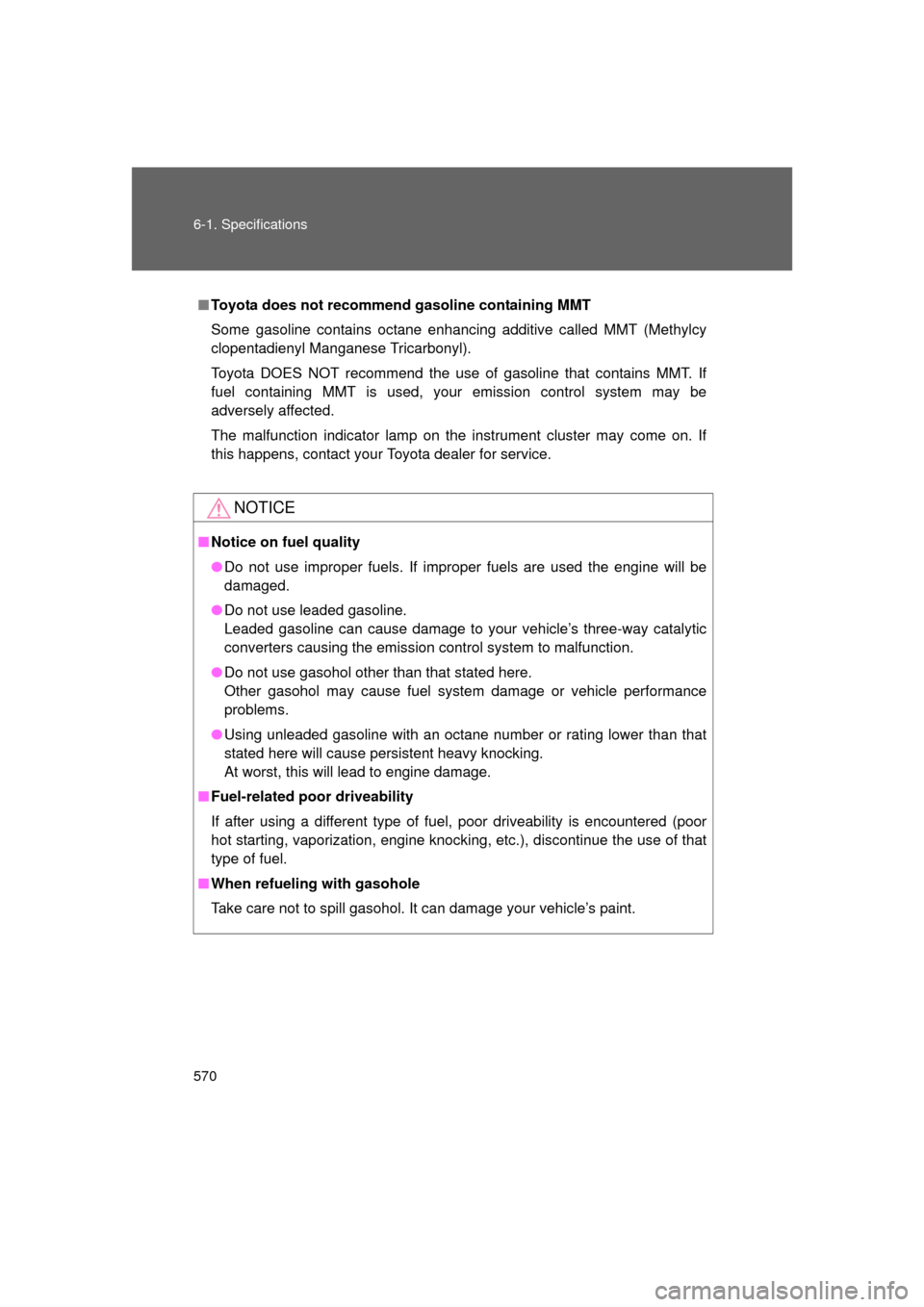
570 6-1. Specifications
L/C200_U (OM60F74U)
■Toyota does not recommend gasoline containing MMT
Some gasoline contains octane enhancing additive called MMT (Methylcy
clopentadienyl Manganese Tricarbonyl).
Toyota DOES NOT recommend the use of gasoline that contains MMT. If
fuel containing MMT is used, your emission control system may be
adversely affected.
The malfunction indicator lamp on the instrument cluster may come on. If
this happens, contact your Toyota dealer for service.
NOTICE
■ Notice on fuel quality
● Do not use improper fuels. If improper fuels are used the engine will be
damaged.
● Do not use leaded gasoline.
Leaded gasoline can cause damage to your vehicle’s three-way catalytic
converters causing the emission control system to malfunction.
● Do not use gasohol other than that stated here.
Other gasohol may cause fuel system damage or vehicle performance
problems.
● Using unleaded gasoline with an octane number or rating lower than that
stated here will cause persistent heavy knocking.
At worst, this will lead to engine damage.
■ Fuel-related p oor driveability
If after using a different type of fuel, poor driveability is encountered (poor
hot starting, vaporization, engine knocking, etc.), discontinue the use of that
type of fuel.
■ When refueling with gasohole
Take care not to spill gasohol. It can damage your vehicle’s paint.
Page 601 of 608
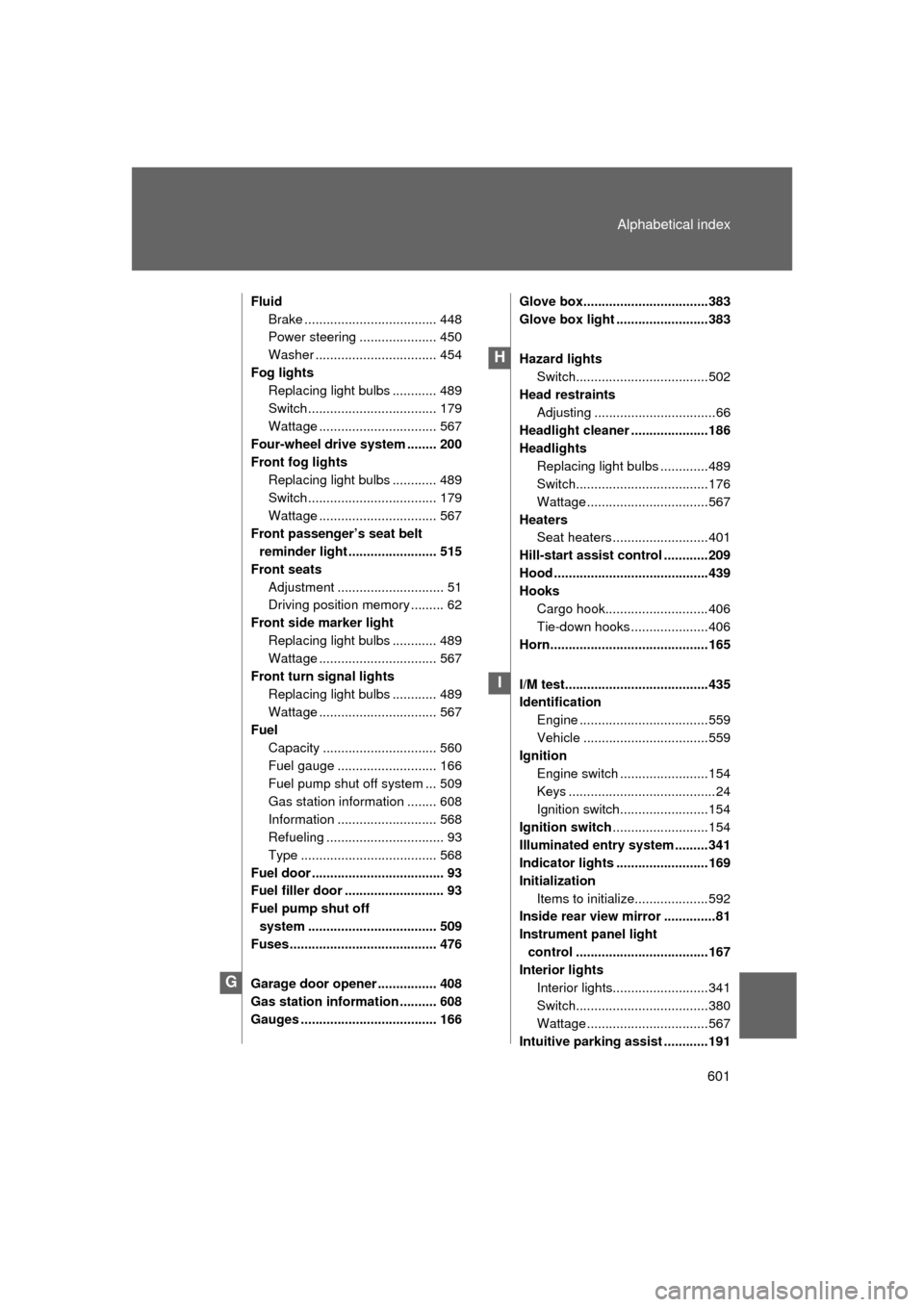
601
Alphabetical index
L/C200_U (OM60F74U)
Fluid
Brake .................................... 448
Power steering ..................... 450
Washer ................................. 454
Fog lights Replacing light bulbs ............ 489
Switch ................................... 179
Wattage ................................ 567
Four-wheel drive system ........ 200
Front fog lights
Replacing light bulbs ............ 489
Switch ................................... 179
Wattage ................................ 567
Front passenger’s seat belt reminder light ........................ 515
Front seats Adjustment ............................. 51
Driving position memory ......... 62
Front side marker light Replacing light bulbs ............ 489
Wattage ................................ 567
Front turn signal lights
Replacing light bulbs ............ 489
Wattage ................................ 567
Fuel
Capacity ............................... 560
Fuel gauge ........................... 166
Fuel pump shut off system ... 509
Gas station information ........ 608
Information ........................... 568
Refueling ................................ 93
Type ..................................... 568
Fuel door .................................... 93
Fuel filler door ........................... 93
Fuel pump shut off system ................................... 509
Fuses ........................................ 476
Garage door opener ................ 408
Gas station information .......... 608
Gauges ..................................... 166 Glove box..................................383
Glove box light .........................383
Hazard lights
Switch....................................502
Head restraints Adjusting .................................66
Headlight cleaner .....................186
Headlights
Replacing light bulbs .............489
Switch....................................176
Wattage .................................567
Heaters Seat heaters ..........................401
Hill-start assist control ............209
Hood ..........................................439
Hooks Cargo hook............................406
Tie-down hooks .....................406
Horn...........................................165
I/M test.......................................435
Identification Engine ...................................559
Vehicle ..................................559
Ignition
Engine switch ........................154
Keys ........................................24
Ignition switch........................154
Ignition switch ..........................154
Illuminated entry system .........341
Indicator lights .........................169
Initialization Items to initialize....................592
Inside rear view mirror ..............81
Instrument panel light
control ....................................167
Interior lights
Interior lights..........................341
Switch....................................380
Wattage .................................567
Intuitive parking assist ............191
G
H
I
Page 608 of 608
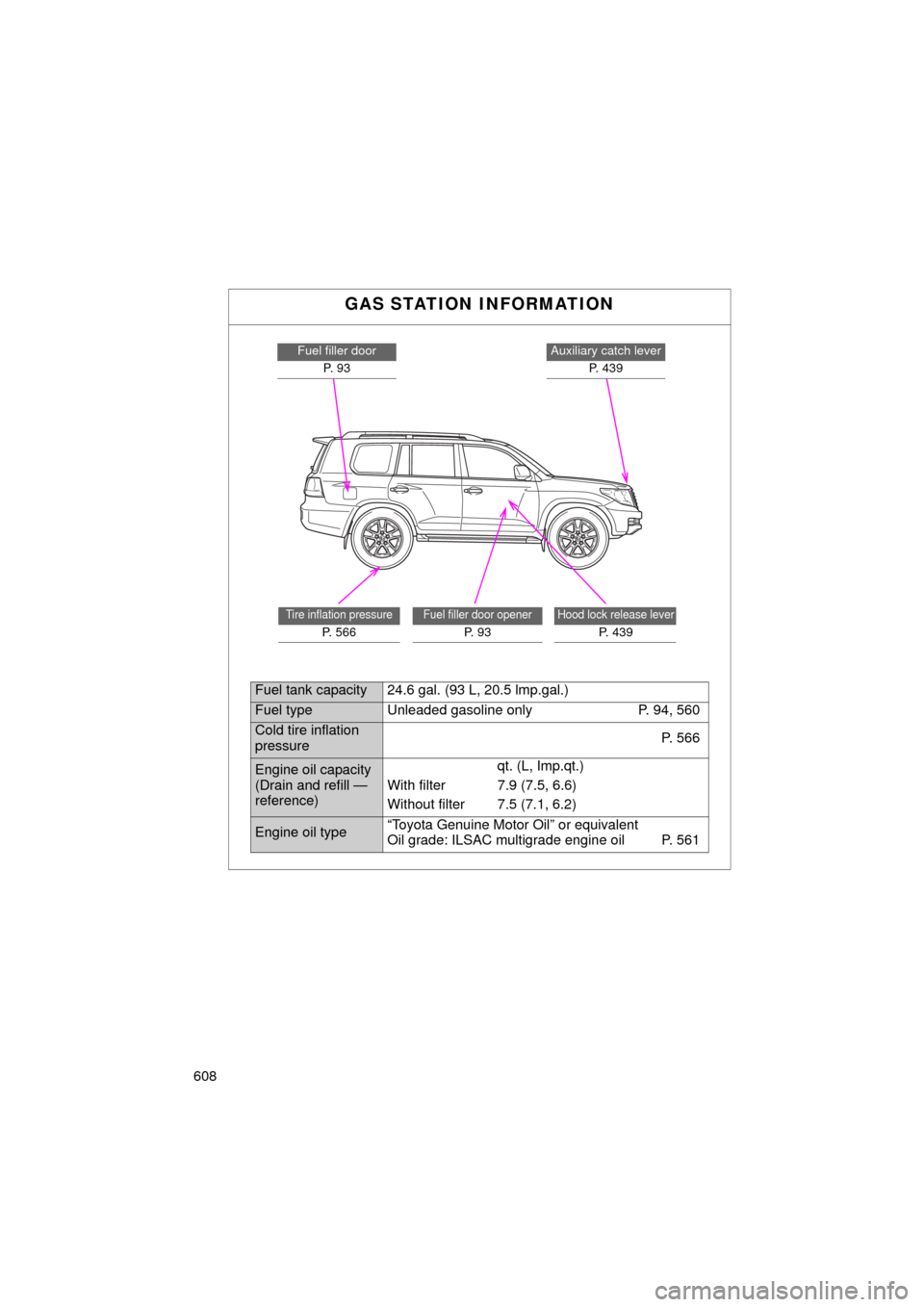
608
L/C200_U (OM60F74U)
GAS STATION INFORMATION
Auxiliary catch leverP. 4 3 9Fuel filler doorP. 9 3
Hood lock release lever
P. 439
Fuel filler door opener
P. 9 3
Tire inflation pressure
P. 566
Fuel tank capacity24.6 gal. (93 L, 20.5 lmp.gal.)
Fuel typeUnleaded gasoline only P. 94, 560
Cold tire inflation
pressureP. 5 6 6
Engine oil capacity
(Drain and refill —
reference)qt. (L, Imp.qt.)
With filter 7.9 (7.5, 6.6)
Without filter 7.5 (7.1, 6.2)
Engine oil type“Toyota Genuine Motor Oil” or equivalent
Oil grade: ILSAC multigrade engine oil P. 561